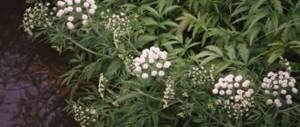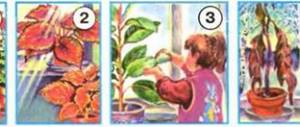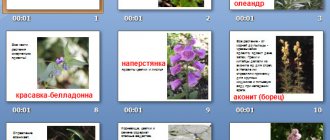Medicinal plants. Herbs are healers. - presentation
Medicinal plants.
Herbs are healers. All herbs are healers - oregano, and St. John's wort, and lungwort, and strawberries, and blueberries, and lingonberries and blueberries. Celandine, wormwood, viburnum, flax, calendula, nettle. The forest dwellers know where to find these herbs. This is what they are going to tell us about now.
Only for animals?
In what cases do medicinal plants help?
What to collect.
When to collect. Medicinal plants have their most healing powers during certain months.
In what weather should you collect medicinal plants? All medicinal plants are collected only in sunny weather.
How to collect. Stock up in advance with everything you need for collection (bags, scissors, knives).
Where can I collect? Each plant has a specific growing location that you need to know. It should not be collected near highways, in places that have been treated with pesticides, or in places where there are very few medicinal plants.
Should I wash my hands after picking plants? After collecting, be sure to wash your hands with soap!
Collect, protect! Many plants have become rare, so don’t tear them up in vain, leave a few strong, healthy specimens. Know how to properly preserve collected plants.
How to save. Plants are dried in the air in the shade. When drying, place them separately, making sure that no soil, sand or dirt gets on them.
Linden. This is a beautiful deciduous tree with dark bark and a spreading crown. The flowers of this tree are an ancient folk remedy used for colds. Applicable part. Flowers with bracts, buds, leaves, bark, seeds. Harvesting time: flowers and leaves - in June-August, buds in spring, bark in early spring or late autumn.
Ledum. The name comes from the word “bagulit” - to poison. It grows in swamps and has an intoxicating smell. Ledum leaves are used in medicine. Helps with coughs as an expectorant. Applicable part. Grass (stems, leaves, flowers). Collection time. Aug. Sept.
Yarrow. Popularly called soldier's grass. And indeed: it is hardy, brave, and is not afraid of heat, frost, or bad soil. It stops bleeding and heals wounds. Its other name is “Achilles' grass.” Applicable part. Grass (stems, leaves, flowers). Collection time. May August.
Nettle. It is both a weed and a medicine at the same time. Its ancient name comes from the word “coprina” - silk. Fiber was obtained from its stems for the production of fabrics (Andersen “Wild Swans”). This plant can stop bleeding and saturate our body with vitamins. Applicable part. Leaves and roots with rhizomes. Collection time. Leaves are collected in June-August, roots in late autumn.
St. John's wort. In Rus' it was considered “an herb for ninety-nine diseases.” By royal decree, the plant was transported from Siberia to Moscow. However, in vain - there is a lot of it in our forest. The people endowed her with “terrible power”; they said that she mowed down animals left and right. Hence the name. Apply: grass (stems, leaves, flowers) and leaves. Collection time. June July.
Birch leaves. There is no tree more beautiful than the birch. Birch means light, white. As it turned out, she is not only a beauty, but also an excellent doctor. Birch leaves help relieve swelling of cardiovascular and renal origin. Apply: buds and leaves. Collection time: March, April.
Peppermint leaves. Mint is widely used in folk medicine. Increases appetite, improves digestion, stops stomach cramps and colic, has a calming, anti-inflammatory and analgesic effect. An infusion of the herb is used as an appetite stimulant, as well as for coughing, choking, and headaches. Applicable part. Grass (stems, leaves, flowers). Collection time. June September.
Pine buds. Coniferous tree with red-brown bark. Height up to 40 m. A decoction of the buds is taken for bronchitis, rheumatism, and especially as an antiscorbutic agent. A decoction of the kidneys is used for metabolic disorders accompanied by various skin diseases. The vapors from the bud decoction are an anti-inflammatory, disinfectant and a cough reliever. Applicable part. Needles, young shoots - buds. Collection time. Buds are collected in spring, needles in June.
Chamomile flowers. Chamomile differs from non-odorous chamomile by its strong aromatic odor. The plant is widely used in folk medicine. Water infusion - as an analgesic, soothing, stomach pain. Infusion - for gargling and washing purulent wounds, ulcers and abscesses. When washing blonde hair, chamomile infusion gives it a beautiful golden color. Applicable part. Flower baskets (flowers). Collection time. May August.
Practical work. Determine which medicinal plant is in trays 1, 2, 3, 4. 1 – chamomile 2 – mint 3 – birch leaves 4 – young pine cones
The presentation was made by Primary School Teacher Irina Valerievna Makarova, GOU Secondary School 534, Moscow
How to make Doman cards yourself:
Print the cards on thick paper or cardboard, 2, 4 or 6 pieces per sheet. To conduct classes using the Doman method, the cards are ready, you can show them to your child and say the name of the picture.
Good luck and new discoveries to your baby!
Educational video for children (toddlers and preschoolers) made according to the Doman method “Prodigy from the cradle” - educational cards, educational pictures on various topics from part 1, part 2 of the Doman method, which can be watched for free here or on our Channel Early Childhood Development on YouTube









